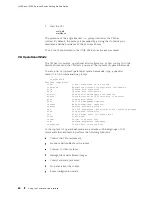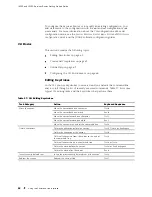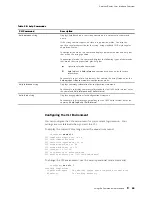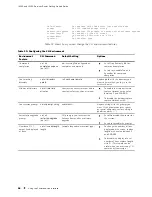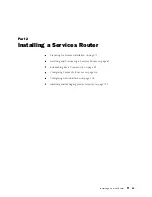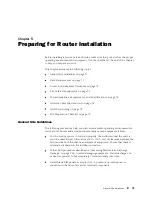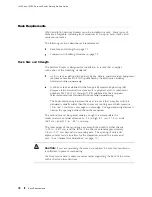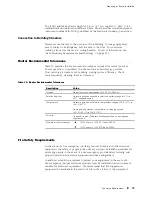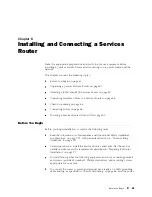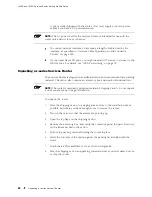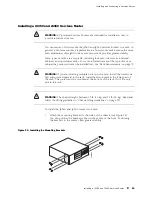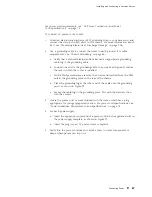
Preparing for Router Installation
The J4350 and J6350 chassis height of 3.5 in. (8.7 cm) equals 2 U. Each
U
is a
standard rack unit defined in Cabinets, Racks, Panels, and Associated Equipment
(document number EIA-310-D) published by the Electronics Industry Association.
Connection to Building Structure
Always secure the rack to the structure of the building. If your geographical
area is subject to earthquakes, bolt the rack to the floor. For maximum
stability, also secure the rack to ceiling brackets. For more information, see
“Rack-Mounting Requirements and Warnings” on page 222.
Router Environmental Tolerances
Table 30 specifies the environmental conditions required for normal Services
Router operation. In addition, the site must be as dust-free as possible.
Dust can clog air intake vents, reducing cooling system efficiency. Check
vents frequently, cleaning them as necessary.
Table 30: Router Environmental Tolerances
Description
Value
Altitude
No performance degradation to 10,000 ft (3048 m)
Relative humidity
Normal operation ensured in relative humidity range of 5% to
90%, noncondensing
Temperature
Normal operation ensured in temperature range of 32°F (0°C) to
104°F (40°C)
Non-operating storage temperature in shipping carton:
–40°F (–40°C) to 158°F (70°C)
Seismic
Designed to meet Telcordia Technologies Zone 4 earthquake
requirements
Maximum thermal output
J4350 chassis: 1092 BTU/hour (320W)
J6350 chassis: 1126 BTU/hour (330W)
Fire Safety Requirements
In the event of a fire emergency involving Services Routers and other network
equipment, the safety of people is the primary concern. Establish procedures for
protecting people in the event of a fire emergency, provide safety training, and
properly provision fire-control equipment and fire extinguishers.
In addition, establish procedures to protect your equipment in the event of a
fire emergency. Juniper Networks products must be installed in an environment
suitable for electronic equipment. We recommend that fire suppression
equipment be available in the event of a fire in the vicinity of the equipment,
Fire Safety Requirements
73
Summary of Contents for J4350
Page 14: ...J4350 and J6350 Services Router Getting Started Guide xiv Table of Contents...
Page 22: ...2 J series Overview...
Page 68: ...J4350 and J6350 Services Router Getting Started Guide 48 Field Replaceable PIMs...
Page 75: ...Services Router User Interface Overview Figure 25 J Web Layout Using the J Web Interface 55...
Page 88: ...J4350 and J6350 Services Router Getting Started Guide 68 Using the Command Line Interface...
Page 90: ...70 Installing a Services Router...
Page 100: ...J4350 and J6350 Services Router Getting Started Guide 80 Site Preparation Checklist...
Page 112: ...J4350 and J6350 Services Router Getting Started Guide 92 Powering a Services Router On and Off...
Page 144: ...J4350 and J6350 Services Router Getting Started Guide 124 Verifying Secure Web Access...
Page 162: ...142 Maintaining Services Router Hardware...
Page 194: ...J4350 and J6350 Services Router Getting Started Guide 174 Troubleshooting Hardware Components...
Page 204: ...184 J series Requirements and Specifications...
Page 220: ...J4350 and J6350 Services Router Getting Started Guide 200 ISDN RJ 45 Connector Pinout...
Page 267: ...Part 5 Index Index 247...
Page 268: ...248 Index...


